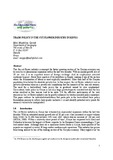| dc.description.abstract | That the cut flower industry is amongst the fastest growing sectors of the Kenyan economy can
be seen by its phenomenal expansion within the last two decades. With an annual growth rate of
20 per cent, it is an important source of foreign exchange. And its employment potential
continues to grow. About three quarters of its workforce is female, making it one of the sectors
where the feminization of labour is most explicitly manifested. More than half of the Kenyan
population lives below the absolute poverty line. In this respect, the cut flower industry’s role in
poverty alleviation takes on a pivotal role considering that the majority of the poor are women.
The need for a horticultural trade policy that is gendered cannot be over emphasized.
Horticultural trade policy in Kenya is not only large grower/exporter oriented but also the key
actors involved in this process tend to be male. Yet the effective participation of the poor
workers in the cut flower industry can be greatly enhanced by worker-oriented policy measures.
This paper outlines the individuals/institutions that participate in the horticultural trade policy
formulation process to inform how gender inclusive it is and identify potential entry points for
women’s voices to be incorporated. | en |

